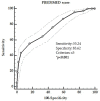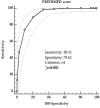Adherence to the Mediterranean Diet as a Modifiable Risk Factor for Thyroid Nodular Disease and Thyroid Cancer: Results From a Pilot Study
- PMID: 35782938
- PMCID: PMC9247581
- DOI: 10.3389/fnut.2022.944200
Adherence to the Mediterranean Diet as a Modifiable Risk Factor for Thyroid Nodular Disease and Thyroid Cancer: Results From a Pilot Study
Abstract
Iodine deficiency is the most important established nutritional risk factor for the development of thyroid nodular disease. Nevertheless, to the best of our knowledge, to date no study focused on the association between the adherence to the Mediterranean diet (MD) and thyroid nodular disease. Adherence to the MD was evaluated using the PREvención con DIetaMEDiterránea (PREDIMED) questionnaire. Physical activity, smoking habits, and anthropometric parameters were studied. PREDIMED was used to evaluate the degree of adherence to the MD. Evaluation of fine needle aspiration cytology of thyroid lesions based on 2013 Italian thyroid cytology classification system. Cytology of thyroid nodules was carried out through sonography-guided fine-needle aspiration and patients were divided into 5 categories: TIR2, TIR3a, TIR3b, TIR4, and TIR5. The study population consisted of 794 subjects (554 females, 69.8%), aged 18-65 years, with BMIs ranging from 19.4 to 55.3 kg/m2. Thyroid nodular disease was present in 391 participants (49.2%), and the most frequent cytological categories was TIR2 (18.3 %), followed by a TIR4 (8.9 %). The presence of thyroid nodules was also significantly associated with the lowest adherence to the MD (OR 6.16, p < 0.001). Patients with TIR5 had the lower adherence to the MD (2.15 ± 1.12 score) compared to other TIRs (p < 0.001). The cytological category with high-risk of malignancy (TIR4/TIR5) was significantly associated with the lowest adherence to the MD (OR 137.55, p < 0.001) and PREDIMED score (OR = 0.33, p < 0.001, 95% IC = 0.26-0.41, R 2 = 0.462). At multiple regression analysis, PREDIMED score was the main predictor of both the presence of nodules (p < 0.001) and the cytological category with high-risk of malignancy (p < 0.001). At ROC analysis PREDIMED score ≤ 5 and ≤ 4 (p = 0.001) were the values that predicted the presence of thyroid nodular disease and cytological category with high-risk of malignancy, respectively. In conclusion, our study demonstrated that the low adherence to the MD is associated with the presence of thyroid nodular disease and in particular with those at high-risk of malignancy.
Keywords: FNA; Mediterranean diet (MD); PREvención con DIeta MEDiterránea (PREDIMED); Tir; fine needle aspiration (FNA); nutritionist; thyroid cancer; thyroid nodular disease.
Copyright © 2022 Barrea, Muscogiuri, Alteriis, Porcelli, Vetrani, Verde, Aprano, Fonderico, Troncone, Colao and Savastano.
Conflict of interest statement
The authors declare that the research was conducted in the absence of any commercial or financial relationships that could be construed as a potential conflict of interest.
Figures




Similar articles
-
Repeat thyroid FNAC: Inter-observer agreement among high- and low-volume centers in Naples metropolitan area and correlation with the EU-TIRADS.Front Endocrinol (Lausanne). 2022 Sep 15;13:1001728. doi: 10.3389/fendo.2022.1001728. eCollection 2022. Front Endocrinol (Lausanne). 2022. PMID: 36187133 Free PMC article.
-
Influence of the Mediterranean Diet on 25- Hydroxyvitamin D Levels in Adults.Nutrients. 2020 May 16;12(5):1439. doi: 10.3390/nu12051439. Nutrients. 2020. PMID: 32429342 Free PMC article.
-
Predictive factors of malignancy in pediatric patients with thyroid nodules and performance of the Italian classification (SIAPEC 2014) in the outcome of the cytological FNA categories.Endocrine. 2021 Nov;74(2):365-374. doi: 10.1007/s12020-021-02784-0. Epub 2021 Jun 14. Endocrine. 2021. PMID: 34128176 Free PMC article.
-
Operation rate and cancer prevalence among thyroid nodules with FNAC report of suspicious for malignancy (TIR4) or malignant (TIR5) according to Italian classification system: a systematic review and meta-analysis.Endocrine. 2022 Oct;78(1):24-31. doi: 10.1007/s12020-022-03165-x. Epub 2022 Aug 20. Endocrine. 2022. PMID: 35986840 Free PMC article.
-
Risk of Malignancy (ROM) of Thyroid FNA Diagnosed as Suspicious for Malignancy or Malignant: an Institutional Experience with Systematic Review and Meta-Analysis of Literature.Endocr Pathol. 2020 Mar;31(1):52-56. doi: 10.1007/s12022-019-09602-4. Endocr Pathol. 2020. PMID: 31898282
Cited by
-
Sex-differences in Mediterranean diet: a key piece to explain sex-related cardiovascular risk in obesity? A cross-sectional study.J Transl Med. 2024 Jan 10;22(1):44. doi: 10.1186/s12967-023-04814-z. J Transl Med. 2024. PMID: 38200498 Free PMC article.
-
Adherence to Mediterranean Diet: Any Association with NAFLD?Antioxidants (Basel). 2023 Jun 21;12(7):1318. doi: 10.3390/antiox12071318. Antioxidants (Basel). 2023. PMID: 37507858 Free PMC article.
-
The Effect of Mediterranean Diet on Thyroid Gland Activity.Int J Mol Sci. 2024 May 28;25(11):5874. doi: 10.3390/ijms25115874. Int J Mol Sci. 2024. PMID: 38892060 Free PMC article.
-
Role of Mediterranean diet in endocrine diseases: a joint overview by the endocrinologist and the nutritionist.J Endocrinol Invest. 2024 Jan;47(1):17-33. doi: 10.1007/s40618-023-02169-2. Epub 2023 Sep 11. J Endocrinol Invest. 2024. PMID: 37697017 Free PMC article. Review.
-
Association Between Anthropometric Measurements and Mediterranean Lifestyle in Women Diagnosed with Hashimoto's Thyroiditis: Data from the Mediterranean Region.Nutrients. 2025 Mar 3;17(5):892. doi: 10.3390/nu17050892. Nutrients. 2025. PMID: 40077762 Free PMC article.
References
LinkOut - more resources
Full Text Sources

